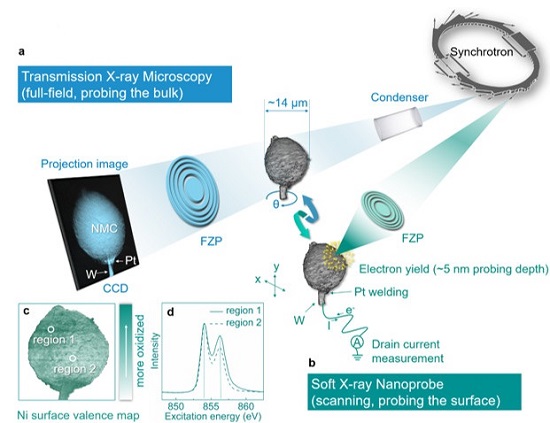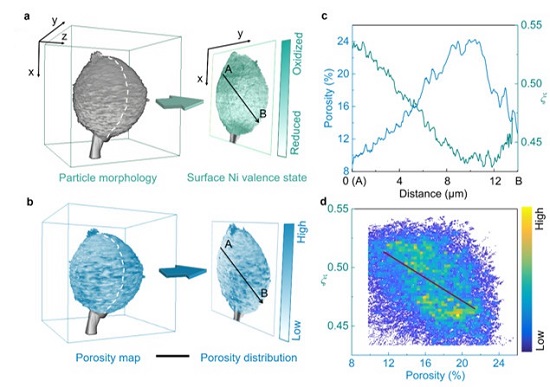
Figure 1. Schematic illustration of the correlative imaging for an NMC811 secondary particle. In the full-field TXM measurement (a, light blue color), the transmission images of the particle were acquired as the sample is rotated in a tomographic scan. In the soft x-ray nanoprobe measurement (b, dark green color), the total electron yield (TEY) signal is recorded by measuring the drain current. Through raster scanning the particle with respect to the focal point, the surface chemical inhomogeneity (c) is revealed based on the energy dependent local TEY signal (d) over different surface regions.
Lithium ion battery (LIB) is a ground-breaking development in the energy storage technology that has substantially impacted the modern society. Among all the components of a LIB, the cathode is the most significant limiting factor for further improvements of the energy and power densities. Comparing to other cathode candidates for the next-generation LIB, Ni-rich NMC (LiNixMnyCozO2; x+y+z ≈ 1, x ≥ y+z) layered oxides exhibit advantages in their practical energy density. However, these materials suffer from unwanted surface reactions and phase transformations that degrade the performance, especially at high voltage. While the importance of the surface chemistry is well-appreciated, a systematic study of the heterogeneous reaction pattern over the surface of the individual particles is not yet available. More importantly, how does the bulk microstructure interact with the surface chemistry is an outstanding question yet to be addressed. Such a study is nontrivial because it requires a suite of complementary and advanced experimental tools with varying probing depth, nanoscale spatial resolution, and sufficient chemical sensitivity.
In this study, Li et al. tackle this question by a systematic investigation of a single LiNi0.8Mn0.1Co0.1O2 (NMC811) secondary particle at its charged state using multiple x-ray probes with nanoscale spatial resolution in both soft and hard x-ray regimes. They investigated the three-dimensional (3D) microstructure of the particle using full-field transmission hard x-ray microscopy (TXM, BL6-2c of SSRL) and the corresponding surface Ni valence state using scanning soft x-ray nanoprobe (BL13-1). Using the correlative nano-resolution imaging technique (See illustration in Fig. 1), the researchers realized a direct visualization of the structural and chemical complexity throughout a single NMC811 secondary particle. More importantly, they made a one-to-one correlation between the surface valence mapping (Fig. 2a) and the bulk porosity mapping data (Fig. 2b). An inversed correlation in the position dependent profiles are observed through this correlative multi-modal imaging approach. These experimental observations informed an in-depth finite element modeling, which computes the co-evolution of the Li/charge distribution, stress, and intergranular fracture in an NMC particle upon charging.

Figure 2. The correlation between the local surface reconstruction and the bulk porosity. a, The particle morphology and the surface (~5 nm depth) Ni valence state distribution. b, The bulk porosity map. c, The line profile from points A to B as illustrated in (a) and (b). The x is the ratio between the TEY intensity at 856.2 eV and the sum of that at 854.0 eV and 856.2 eV pixel by pixel, which represents relative Ni valence state. d, The correlation plot for all the data points in (a) and (b). The plot is color coded to the density of the data point (see colormap in the inset). A weak but clear negative correlation (see regression line in (d)) is observed between the surface Ni valence state and the bulk porosity. The scale bar in (b) is 5 μm.
This work demonstrates a surface-to-bulk mutual modulation effect, which involves interplay among the charge heterogeneity, bulk fracture, and surface passivation at the single-particle level. The fundamental understanding of the coupling effect between the surface chemistry and the bulk microstructure highlights that both crack mitigation and surface modification are key points that shall be considered in an integrated manner for the design of the next generation cathode materials for LIBs industry. The herein developed correlative nano-resolution imaging method (with both hard and soft x-ray probes) not only paves a new way toward more comprehensive understanding of LIBs material, but also will have profound impacts on a broad range of scientific fields well beyond battery research.
S. Li, Z. Jiang, J. Han, Z. Xu, C. Wang, H. Huang, C. Yu, S.-J. Lee, P. Pianetta, H. Ohldag, J. Qiu, J.-S. Lee, F. Lin, K. Zhao and Y. Liu “Mutual Modulation between Surface Chemistry and Bulk Microstructure within Secondary Particles of Nickel-rich Layered Oxides”, Nat. Commun. 11, 4433 (2020) doi: 10.1038/s41467-020-18278-y




